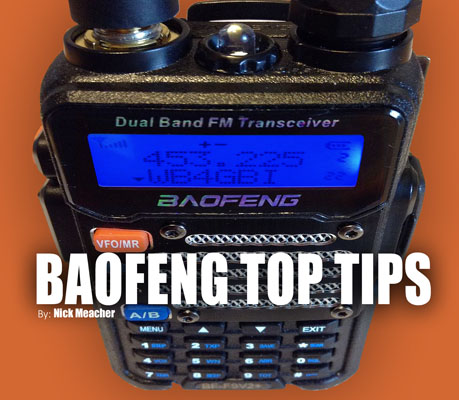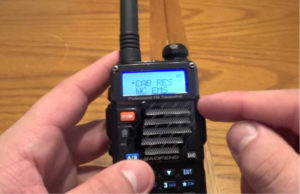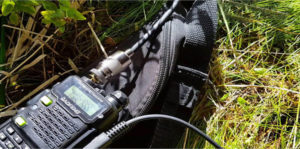
We have written several articles on programming and using the Baofeng radios. In this article, we will focus on some key information as well as some valuable tips for using the radio. Most of the basic menu functions in the Baofeng are the same in the BTECH brand, although BTECH mobile radios have additional menu items.
VFO versus MEM
When you turn the radio on it will usually say “frequency mode” or “channel mode.”
Frequency mode is the same as VFO, so the orange button will switch you between frequency mode and channel mode (“MR” on the VFO/MR button).
Frequency mode allows you to program a frequency into the radio, as well as other variables, discussed below.
Channel, or memory, mode (MR) is where you can select a channel that you have previously programmed into the radio. A channel contains the frequency, offset, shirt, CTCSS and other parameters to access a particular repeater, or it can be a simplex frequency that you have saved.
Menu
The menu button gives you access to the functions of the radio, such as frequency shift, CTCSS, etc. Each function has a menu number which is displayed in the upper right corner below the battery indicator. Menu items can be selected by the up and down arrows or by entering the menu number.
When the menu item is selected press MENU again to make changes to the menu item.
Saving to Memory
If programming from the keypad and you wish to save what you have entered in frequency mode, you must first delete the existing contents of the memory location before you can save.
Delete memory/channel (DEL-CH) is menu 28.
Save to memory (MEM-CH) is menu 27.
Receive Frequency
The receive frequency (output of the repeater) or simplex frequency is entered on the keypad when in channel mode.

Offset
The offset is the shift, or difference between the receive frequency and transmit frequency. The standards are 2m = 0.6MHz (or 600kHz) 70cm = 5.00MHz. 1.25m = 1.6MHz. OFFSET is menu 26.
The offset direction+ or – must be set manually. SFT-D is menu 25.
When you look repeater information up on repeaterbook.com you will usually see the (radio) receive frequency with a + or – after it to indicate the shift direction.
CTCSS or DCS
A repeater may have a tone that is required to access it. It will either be an analog tone or a digital tone. There is a standard table and it is built into the radio memory. An analog tone will have a decimal, i.e., 123.0. A digital tone will be three digits.
Analog tone is menu 13 T-CTCS. Digital tone is T-DCS menu 12.
You will see R-CTCS and R-DCS – these are receiving tones. Some repeaters send out a tone that you can program in. In most circumstances it is best to leave it set to OFF unless you get interference. This is the most common problem when people say they can’t hear the repeater, they have a receive tone set when the repeater doesn’t transmit on.
External Antennas
If you are connecting an external antenna to your handheld, you should use a strain relief cable. This is a short, thin length of coax with a SO-239 connector on one end that connects to the antenna cable and a SMA-M connector that will connect to the radio.
I would be negligent if I didn’t mention that the Baofeng and BTECH radios will transmit outside of the ham bands. The FCC rules for FRS, GMRS and MURS (frequencies the radios can transmit on) have specific requirements and features for radios to be approved to operant on these frequencies. One rule is that a radio cannot operate in any other band, another is power restrictions.

Final Thoughts
The Baofeng and BTECH radios have significantly reduced the cost to enter into ham radio. They offer some unique capabilities for post SHTF. Their low costs allow you to purchase a number of them and store them away in faraday bags.
You need to know how to use them, you need to know how to talk on the radio, therefore I cannot urge you enough to get a ham license if you do not already have one.
Search for your local ham club and see if they are offering classes. There is also a large amount of fee material to study your Technician license, including written material and videos, see links below.
LINKS
https://www.kb6nu.com/study-guides/
Excellent videos https://www.youtube.com/user/davecasler
App and practice tests https://hamstudy.org/ (some exams also listed)
Find exams
http://www.arrl.org/find-an-amateur-radio-license-exam-session
